LinkedIn used to be considered by most as merely a platform for creating a static online resume and finding a job. After all, the LinkedIn profile structure does resemble a resume; users can summarize their career experiences, showcase particular skills, and list their education and employment history.
But today, LinkedIn has proven to be a fantastic social networking site for business leaders and entrepreneurs wanting to develop their brand, connect with their target market, and establish themselves as thought leaders in their niche. No longer is it just an online resume platform; LinkedIn has now become an avenue for professionals to attract a following and provide value to their audience by creating content.
Every year, LinkedIn gives recognition to the world’s top 300 content creators and influencers by assembling a list of LinkedIn Top Voices. These top 300 people are selected out of LinkedIn’s 722 million users.

Top Voices are LinkedIn’s way of recognizing users who upheld meaningful conversations, inspired innovation, and elevated the topics relevant to their respective industries. These top voices are people who made use of every available medium on LinkedIn—videos, posts, articles, and comments—to convey the message they are passionate about, and who eventually generated the most engagement on the platform.
I know this all sounds terrific. However, being an influence on LinkedIn is easier said than done.
With millions of people posting thousands upon thousands of content each day, it can be a struggle to attract attention and gain enough momentum to boost your brand. And besides, being a LinkedIn Top Voice entails so much more than just consistently posting high-value content and being a leader in your community. It’s ultimately about communicating, listening, and building a tribe, which all take time, courage, and a whole lot of passion.
It’s for these exact reasons that we invited one of LinkedIn’s Top Voices, String Nguyen, for one of our training webinars to share her knowledge and experience about being a major influencer and content creator.

Co-hosted by Dubb Chief Revenue Officer Darius Santos and myself, Ruben Dua, the webinar primarily tackled video content creation, personal branding, social selling, and LinkedIn marketing.
String has been a LinkedIn Top Voice honoree for four consecutive years now. She is a trusted guide to LinkedIn marketing and is the founder of The Trusted Voice, a startup that helps experts and professionals strengthen their authority within their niche using content and video creation. Within String’s The Trusted Circle, a community-driven membership, professionals are taught how to gain brand clarity, create authentic content, grow their network, and scale their brand.
String has a reputation for growing an audience on different channels. She first amassed 44,000 followers on Meerkat, but that quickly died within six months. Finding out the hard way that it’s not ideal to be overly reliant on only one channel to establish your brand and reach your market, String learned the value of simultaneously growing an audience in various media. While LinkedIn is a great channel for marketing your brand, it’s still best to branch out into using other social platforms at the same time. In addition to doing Meerkat, String has spent the past four years garnering 15 million views and attracting over 64,000 followers by completing newsletters.
Aside from attracting large audiences, String has organized no less than 100 parties for her community. She believes in the power of meeting both online and offline in forming strong connections and finding potential clients.
See, establishing yourself as an authority figure and a thought leader in your space doesn’t happen overnight. It takes time to gain followers and build a brand both on a personal and professional level. But that shouldn’t stop you. The goal is to start right from wherever you are and begin finding your way to success from there.
Before we get into the techniques and strategies for growing on LinkedIn, let’s first take a refresher on branding.
String’s Original Theory on Personal Branding
How does branding work?
Branding is like inception. It involves cementing and nurturing a memory or an impression about you and your brand into consumers’ minds using visuals—logos, colors, and images.
Take String’s brand, for example. She loves fried chicken so much that she chose to associate her brand with it. She incorporates this on her LinkedIn content by inserting emojis and images of fried chicken into wherever she finds relevant. She uses fried chicken as a visual to trigger people’s memories into recognizing her content as distinct from others.
But that’s not all there is to branding. Your products or services are not the only things you should be “packaging.” Branding doesn’t only have to do with your visual identity but also with who you are as an individual and how you communicate your values.
Hence, personal branding.
But what exactly does it mean to have a personal brand?
Personal branding is how you package yourself.
Think of personal branding as self-packaging. Your brand is essentially an extension of your personality, and you’re trying to convey that to people through different media.
You already have the expertise, the knowledge, and above all, you have something to say. So in marketing your brand, you shouldn’t hold back by being afraid of what people might say about you.
Remember, you can’t please everybody. Moreover, you have to recognize that you’re not creating content to become famous; you’re creating content to share your knowledge and expertise.
Make it your aim to provide as much value as possible to people—it’s less about you and more about what you can offer. Keep in mind that only a specific audience who resonates with your content will like you for you, but most people will follow you because they know how valuable the knowledge is that you’re imparting to them.
Especially now that most of our human interactions are becoming more virtual, you have to have enough confidence to try and prove yourself reliable despite the boundaries. People won’t immediately book a call with you if they don’t trust you. You have to give them a reason to trust you and ultimately do business with you. Which only means that you have to package yourself online in such a way that effectively communicates credibility, proves authenticity, and adds value.
Personal branding is how you position yourself.
For figuring out how to find your feet, String came up with the 7Vs to personal branding:
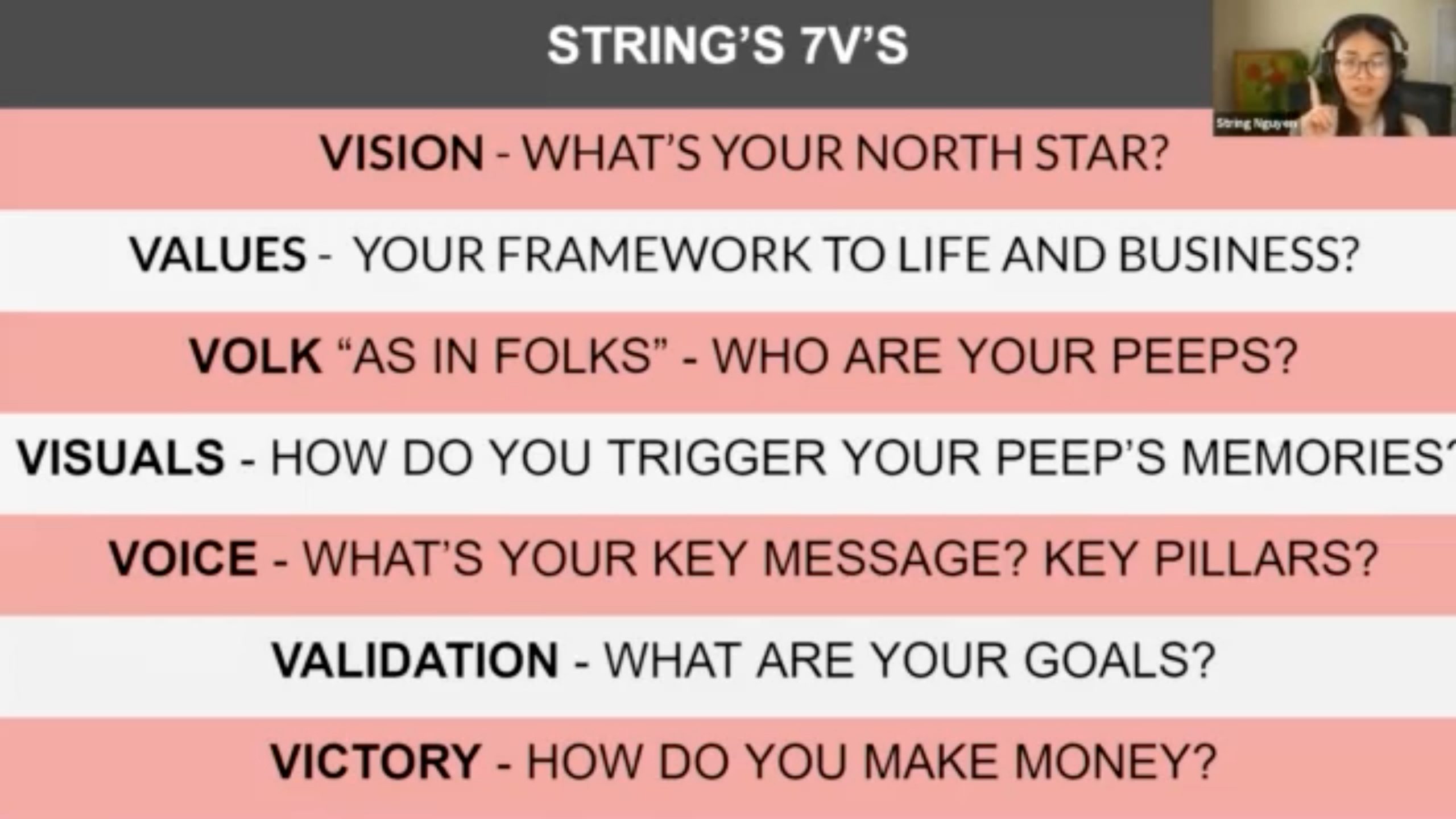
1. Vision
What’s your North Star?
The first step to growing your influence is knowing your “why.” Imagine yourself as the captain of a ship, and you’re following your North Star. Where is that star leading to?
In developing your vision statement, think about what kind of impact you want to leave in the world. String’s vision is to increase creativity in the world and help thought leaders become great influencers on LinkedIn.
2. Values
What’s your framework for life and business?
The only way to be authentic is to align what you do with your values.
There are two types of values:
- Business Values
These equate to your value proposition. A business value is essentially your unique selling point.
- Personal Values
These are the list of things that drive your life and give you a sense of purpose.
Work with people and brands that have similar values as you do. This will help you attract your tribe and maintain your authenticity. Misaligning with your personal values may result in disruptions, as they are at the center of your being, and conflicting with who you are isn’t very conducive to accomplishing your purpose.
3. Volk
Who are your people?
“Volk,” as in folks.
Before you can build your influence, you have to identify the people you want to serve and attract.
And again, you can’t capture the interest of everyone. It’s the first step to knowing your people: acknowledging that not everyone on LinkedIn is your people. Adding everyone on LinkedIn is just adding randoms. String suggests being selective and giving much thought about choosing whom you want to collaborate and partner with. Ultimately, your LinkedIn connections make up the list of potential people you’re planning to form long-term relationships with.
4. Visuals
How do you trigger your people’s memories?
Fried chicken. It’s String’s visual brand anchor and identity. What’s yours?
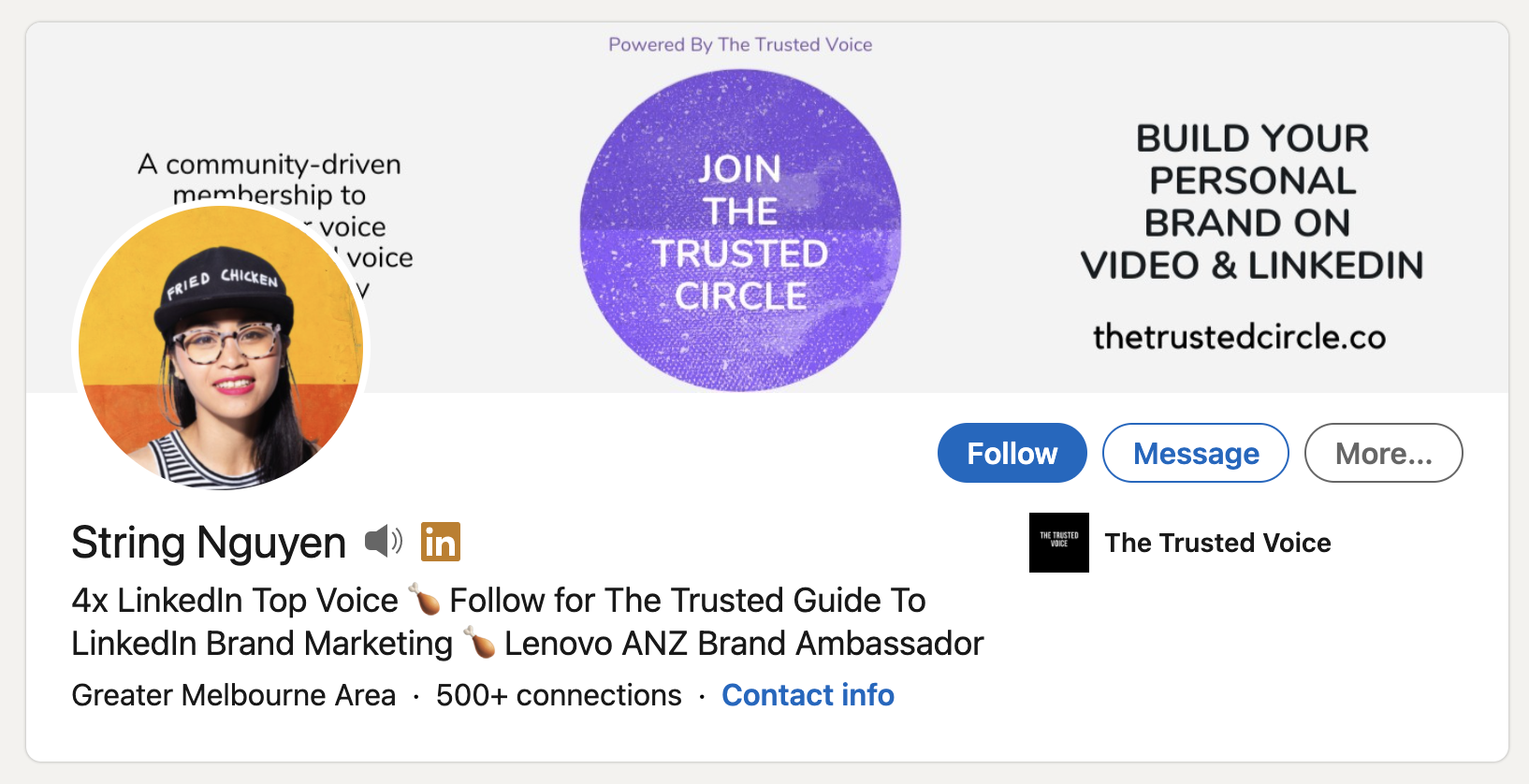
String’s habit of inserting fried chicken emojis into her LinkedIn posts allows her to catch people’s attention. Whenever LinkedIn users see fried chicken on their feed, they immediately recognize the post as String’s, which, of course, makes them stop to take time to read.
Visual brand anchors also help you easily identify the people who are part of your circle. They can become somewhat of an inside joke for your people. String is able to instantly identify the people from her community when she sees that they’ve sent her fried chicken. It’s their code for club.
But aside from the graphics and visual anchors, know that you are ultimately the face of your brand. By introducing yourself as a person to your audience, you are already creating your brand’s visual identity. You are your brand.
People are searching for people they can trust to do business with. What better way to prove your credibility and authenticity than by showing them your face and personally communicating with them?
5. Voice
What’s your key message? What are your key pillars?
In order to increase your influence, your voice must reinforce your values, visuals, and vision. It’s what attracts your people.

Having a voice means having your personality infused into the way you communicate. Your voice is what helps your message become heard amid all of the noise coming from everybody else.
Finding your voice involves identifying the core pillars that you are trying to reinforce. String’s core pillars are video, personal branding, and LinkedIn marketing.
6. Validation
What are your goals?
This is where your metrics of success come in. What are your short-term and long-term goals for your business?
Your goals can be content-driven. For example, you could measure your short-term success with how many posts you are able to publish per day or how many profile views you’re getting.
They can also be revenue-driven. This could mean establishing your determining factors as the number of leads you get or the number of sales you are able to close.
7. Victory
How do you make money?
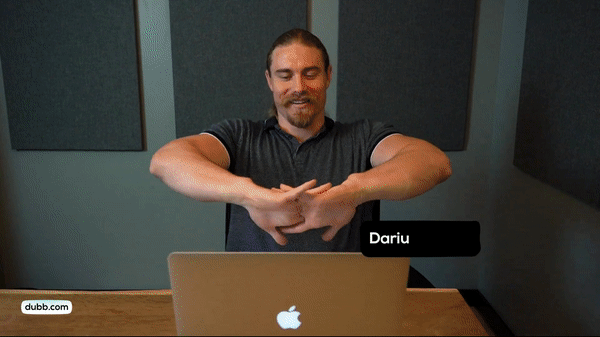
Of course, you’re doing all of these to make a living. And so it’s only right to think about how you’re going to be monetizing what you do and what you offer.
What are your products? How will you construct your sales funnels?
Think about how you’re going to make money as early as day one. Everyone on LinkedIn is either finding a career, building up a network, or using it as a funnel to fuel and build up their business. Everyone on LinkedIn thinks professionally—for the most part, it’s what differentiates LinkedIn from every other social network. So it’s okay to talk shop because doing business is precisely what LinkedIn was made for.
These 7Vs are the layers for developing your brand. Each layer is designed to strengthen your influence and set your personal brand apart from everyone else’s.
But that’s not all.
In the end, there’s one more fundamental question that you should ask yourself…
What’s your thing?
Besides running your business, closing sales, and building your network, what do you do? What’s that one thing that people keep coming to you for? What are you known for? Your “thing” is what you should direct most of your focus on.
It could be something that you’ve been doing for years, and yet people still come to you for it today, over and over. Know this: as long as there’s a demand for something, it’s worth monetizing.
Find your “thing” along with your 7Vs, and you’ll be more than ready to impact people in ways you can’t even imagine.
Five Tips to Grow on LinkedIn
String provided us with five valuable tips to attract a following on LinkedIn. Now, these tips are specifically about content because the best way to grow on LinkedIn is to create content.
Many people struggle with not knowing what type of content they think they should create and post on their LinkedIn or social media accounts. But one of the practices that I’ve found to be true is that questions can be a catalyst for excellent content. As you begin to publish content, people will start to engage with it. And I’ve noticed that as people engage with your content, they get inspired and begin to ask questions and give comments, which can fuel your content calendar.
Tip #1: Types of Content
There are two primary types of content: static content and feed content.
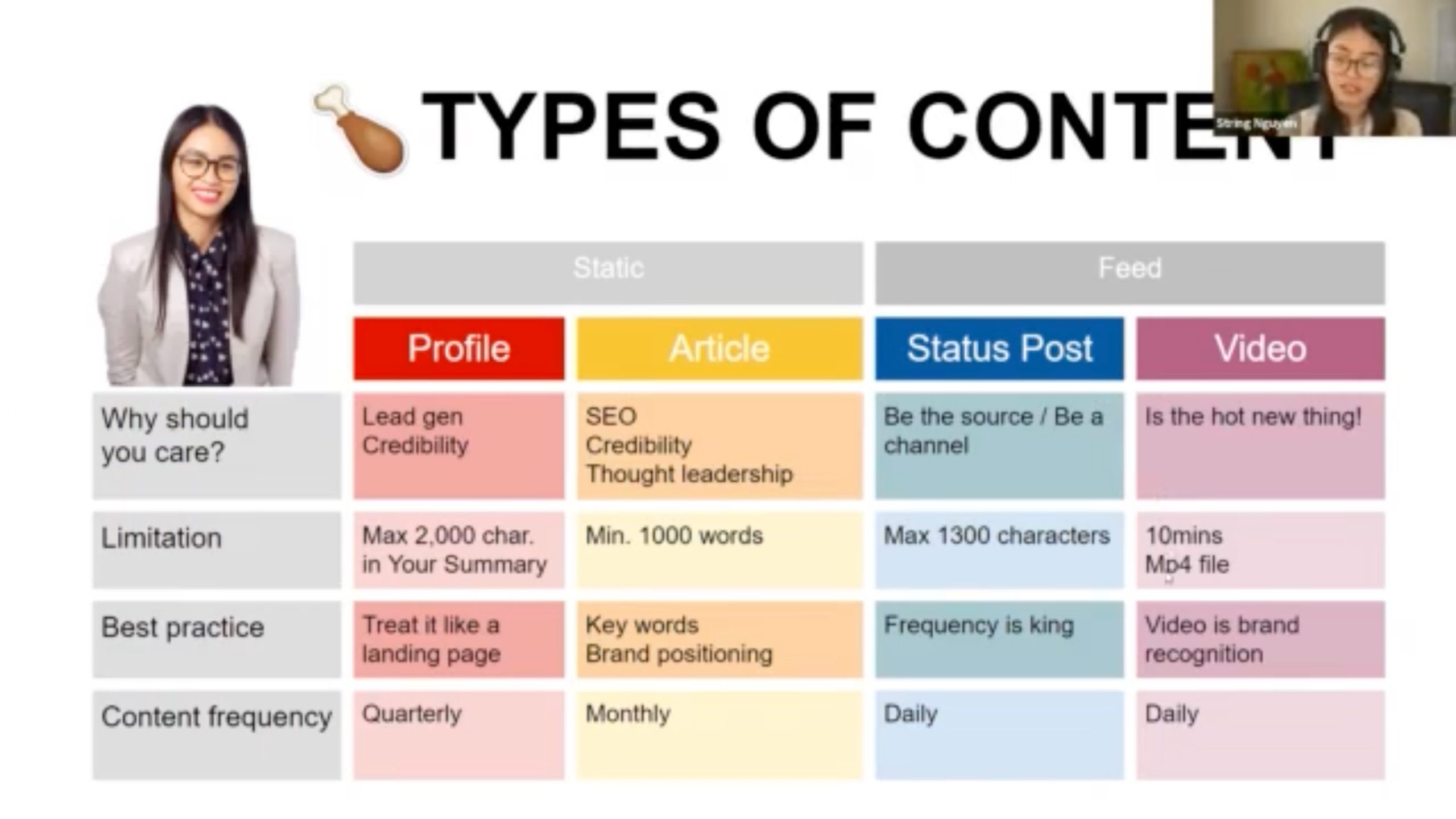
1. Static
Profile
-
- Your LinkedIn profile plays a vital role in lead generation, and it helps establish your credibility.
-
- Your profile is like a resume, but it’s also so much more than that. It’s predominantly your conversion tool and landing page. Thus, you should make it a habit to review and update it quarterly. Treat it like your mini-website, which people will regularly visit to see what you have to offer.
Articles
-
- LinkedIn articles are an excellent means to showcase your expertise and generate brand awareness. By sharing what you know and what you have to say, you’re exhibiting thought leadership, which is sure to prove your credibility.
-
- Ensure that your articles are SEO friendly. This means writing using keywords and keyword phrases that will help increase your article’s visibility. You should write articles with at least 1,000 words and post them once a month.
2. Feed
Status Posts
-
- Status posts get the most views on LinkedIn. To be clear, these are written status posts; no photos or videos, just pure copy. LinkedIn allows you to write a maximum of 1,300 characters, which amounts to about 200 words.
-
- In posting this type of content, you have to remember that frequency is king. If you aspire to be a top voice, then you would have to post daily. Why? Because an audience wants to follow someone and look forward to something. Think about YouTube channels. The reason they’re continually growing is that YouTubers are regularly posting content for their audience to consume.
-
- To determine how many times you’re going to post in a day, consider the size of your audience. If you have under 1,000 connections on LinkedIn, posting once each day is ideal. As the number of your connections grow over time, you should increase how many times you post per day.
Videos
-
- Video is a trust accelerator. Since people want to do business with people, consistently posting high-value video content that shows who you are as a person can help you earn your audience’s trust. What’s more, video is so much more engaging than text. While written LinkedIn posts are perfect for generating engagement, videos are known for cultivating trust.
- If you can create and post videos daily, do it. But if you believe you’re too busy to produce videos or you don’t think you have the right resources, then you’ll be glad to know what Dubb can do for your video production needs. More on Dubb’s features later.
Tip #2: Update your LinkedIn profile
Profile Photo
- Use a clear profile photo. If you want to stand out, especially when you’re leaving comments, your profile photo should have a bit of color.
Banner
- Think of your banner as your advertising board where you would promote your services and your brand. Make it as visually appealing as possible.
Headline
- Use the headline as a pitch to pull people into your profile.
About
- If your About section is written in the third person, consider rewriting it in the first person. Take it as an opportunity to share your story, your value proposition, and your 7Vs. Expand on the problem you’re trying to solve and the solution you’re offering, and maybe share a few testimonials and success stories. Toward the end, remind people of what to do next.
- Don’t forget to add in your personality. Think of how you can curate your About that it compels people to connect with you. If you’re already a Dubb user, consider linking a Dubb video in your About.
Tip #3: Be visual with PDFs
PDFs are like Instagram carousels and are great for standing out in a sea of LinkedIn posts.
Many LinkedIn users prefer posting text-heavy content. And while most professionals on LinkedIn like to read, it’s also beneficial to include visuals along with a well-written copy.
Tip #4: Written post structure
Let’s discuss the things you need to keep in mind when constructing your written posts on LinkedIn.
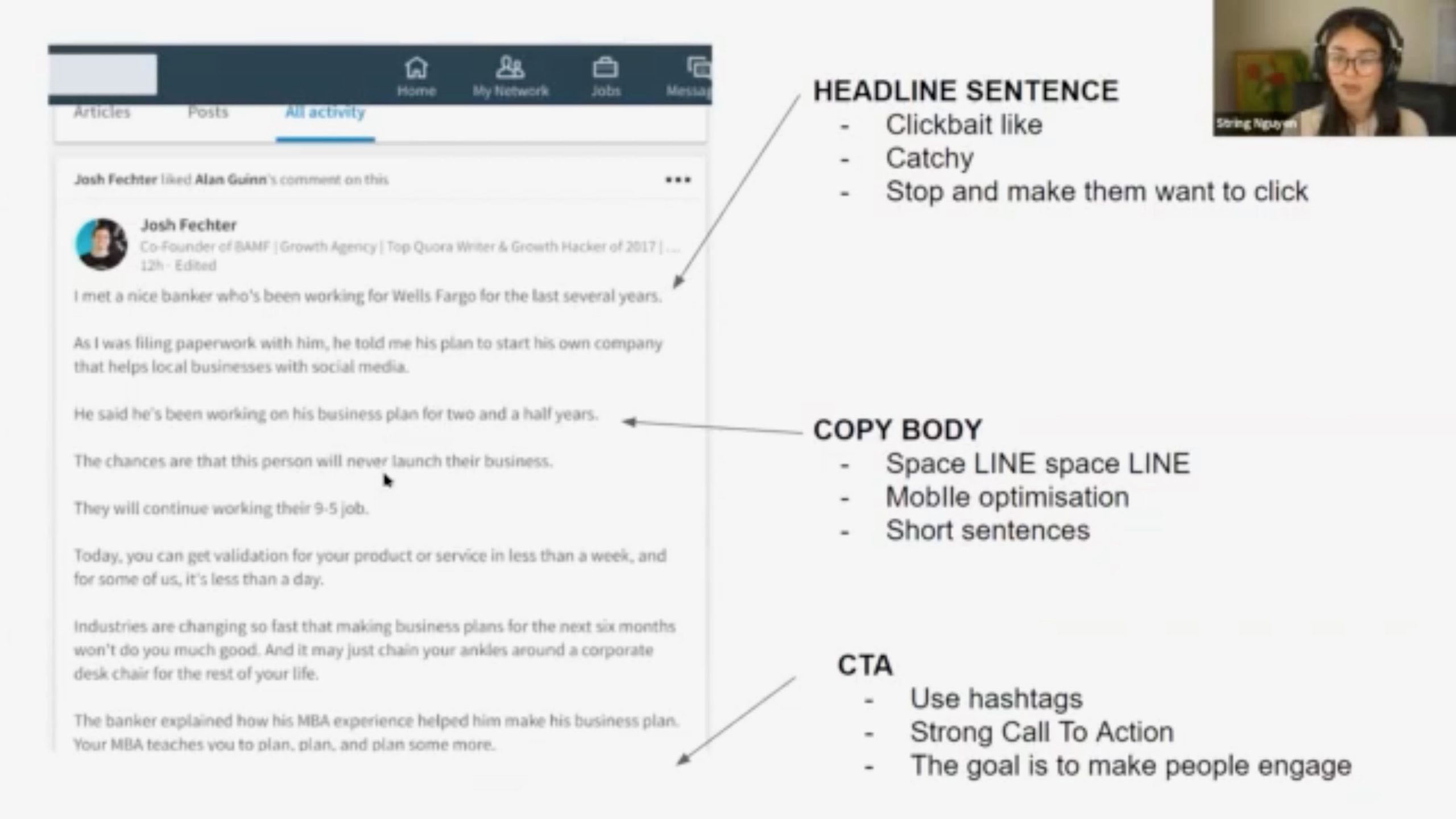
Headline Sentence
First off, use a clickbait title. Come up with a title that will make people stop scrolling and want to click on your post. The first two lines of your post should be really catchy or even polarizing. The more it’s controversial, the more engagement it’s likely to get. But be careful not to be overly controversial.
Copy Body
For the copy’s body, write in short sentences that are separated by line breaks. This makes reading your post on mobile easier and much more fluid.
Call-to-Action
Don’t forget to include hashtags and a call-to-action by the end of the copy. Your goal is to encourage people to engage with your content, and a call-to-action prompts them to do exactly that.
Tip #5: Video is a trust
Video was String’s foray into her success story on LinkedIn. About four years ago, String only recognized LinkedIn as a resume platform. Today, String uses the power of video to grow her influence on LinkedIn even more.
String suggests keeping your videos to under 90 seconds, enough to capture your viewer’s attention, provide value, and communicate a call-to-action. While shooting your videos, don’t be passive. Be confident, be succinct, and make sure to hook your audience in within the first 10 seconds.
Leveraging Dubb to Accelerate Trust
Video is our main focus here at Dubb. We’re continually working on our platform to help people streamline their communication process with their contacts and efficiently produce actionable videos that convert.
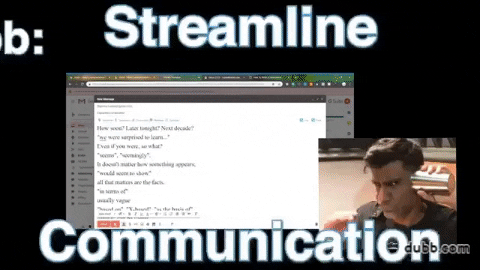
The one thing you need to know about Dubb is that it covers all three components of the video production process: creation, customization, and distribution. Dubb gives you the power to do anything automatically, so you can shift your focus on what’s important.
Creation
Dubb Chrome Extension
Using the Dubb Chrome Extension, you have the option to record your entire screen or a portion of it simultaneous with your webcam feed. With just a few clicks, you can access the Chrome Extension. Hit record, wait for the countdown, and you’re good to go.
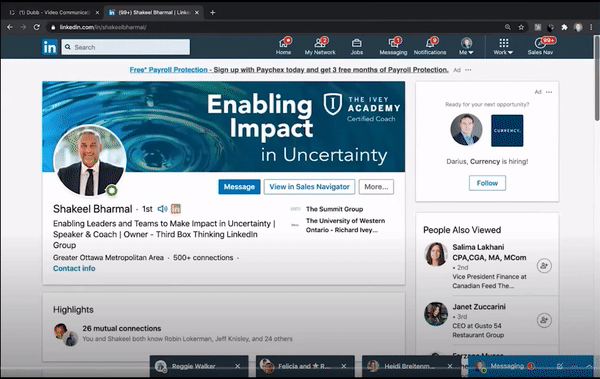
You don’t even have to bother too much about editing your video because the Chrome Extension offers real-time editing features. You can annotate the screen, pause and resume recording, and change tabs while recording.
This feature is especially helpful when you’re trying to connect with someone on LinkedIn—you can screen record your computer while you’re on their LinkedIn profile. These types of messages are much more likely to get higher click rates than plain text or videos with just your face because people will quickly notice their profile and realize that it’s a personalized video made just for them.
If you already have a prerecorded video ready for posting, you can upload that directly to Dubb, and you’ll still get to use all of Dubb’s features.
LinkedIn Direct Integration
Since we’re talking about displaying thought leadership on LinkedIn, let’s explore Dubb’s direct integration with LinkedIn.
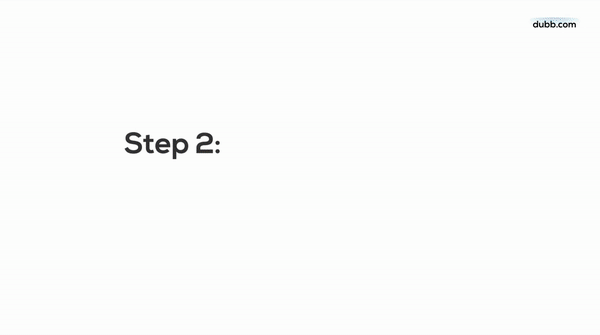
Anywhere you can write a message—Messages, Sales Navigator, Recruiter, comments—there’s going to be a Dubb button that will provide you access to Dubb’s video recording features, your library of videos, and your activity reporting where you can see who among your contacts are watching your videos.
Dubb Mobile App
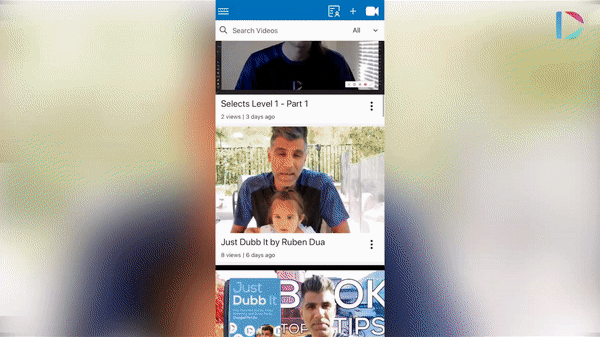
Aside from Dubb’s Chrome Extension and LinkedIn direct integration, there’s also the mobile app available for iOS and Android that offers a ton of handy features; you can splice together video clips, insert text, and add emojis and music.
Customization
Video Landing Page
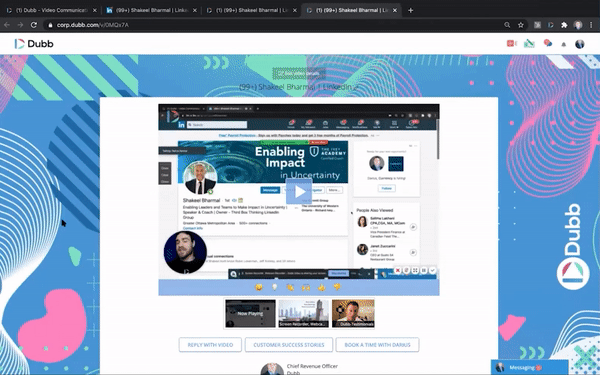
Once you’re done recording your video, Dubb automatically packages it in a landing page that’s complete with your brand’s logo, colors, watermark, and custom background image. These are all added as part of a template, which you are also able to customize. We call them presets.
Presets
Dubb gives you the ability to construct templates for different video pages for different use cases. These templates change every part of your video page, all at once.
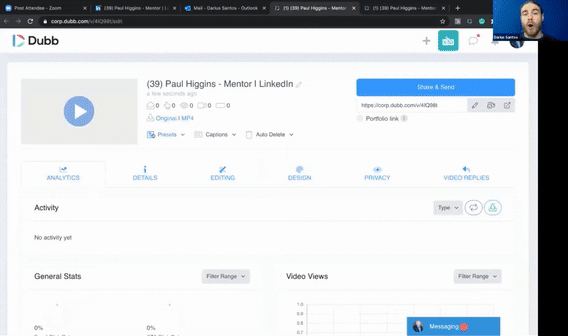
Combined with the power of Dubb’s video landing page, presets do an excellent job of reinforcing your brand identity and capturing your contacts’ attention by consistently displaying your design elements.
Video Playlist
Dubb’s video playlist feature allows you to pick a sequence of videos and upload them together in one video page.The videos will play back-to-back, and your contacts only have to get over the main hurdle of pressing play.
With video playlists, you can get the best of both worlds with custom and prerecorded videos. You might already have professionally produced videos with visuals and graphics ready for sending, but there’s no personalization there.
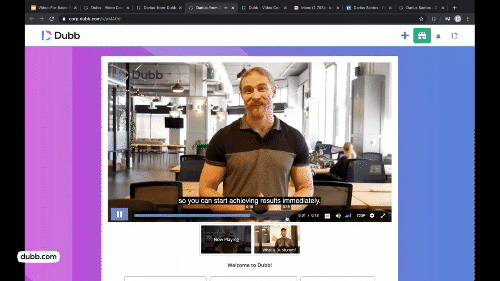
Dubb’s playlist feature lets you publish both simple personalized videos and high-quality videos on one landing page. You can try putting the LinkedIn profile screen recording first, and the pre-produced videos second, then maybe add testimonials, case studies, demos, and social proofs next—basically, include whatever you think is going to bring your contacts from a place of not knowing who you are down to wanting to do business with you and eventually reaching out to you.
Call-to-Action Buttons
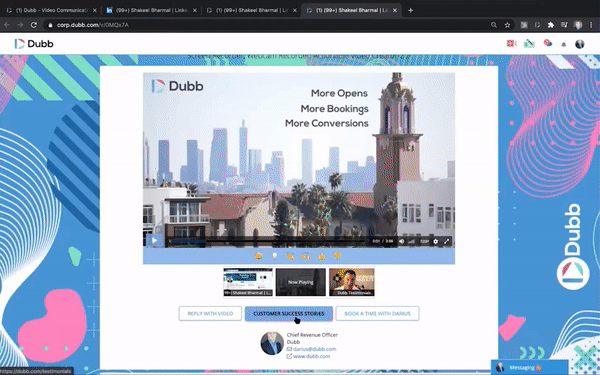
Call-to-action (“CTA”) buttons are devices designed to help make your video convert. In essence, CTAs create the opportunities that you’re looking for. Dubb’s CTAs are fully customizable, which means you can make them into whatever you want: for booking a phone call, sending a text message, filling out a form, downloading an attachment, replying with video, and just about anything you can think of.
Distribution
You’ve shot your video, packaged it, and customized every part of it. We’re down to the final step, which is to distribute your video.
Direct Integration
However you’re communicating with your clients and prospects, Dubb can meet you right where you are.
You can send out Dubb video emails straight from any channel through direct integration, and the message will appear as an animated GIF preview of your video’s first three seconds. It’s a hundred times better than just sending someone a direct URL link. Not only that, but you can also input their first name as personalization text. These features make everything so much more engaging and eye-catching that your click rates are sure to improve.
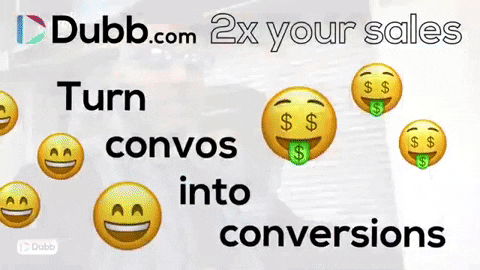
This direct integration extends to several major social, email, and CRM platforms, including LinkedIn, Gmail, HubSpot, Salesforce, Mailchimp, Outlook, and many more. But if ever you’re using a platform that doesn’t support this feature, you don’t have to worry. We’ve got you covered.
Have a look at Dubb’s universal distribution option.
Universal Share and Send
If you want to distribute your videos through social media channels, all you have to do is look for the “copy for email” button, click on it, and then paste that on to your socials. Doing this will still retain your video’s personalization elements and the thumbnail’s ability to appear as a GIF, as long as the medium supports it.
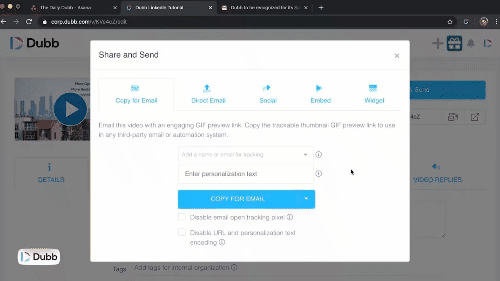
With this universal share and send method, you can send out your videos through Facebook, WhatsApp, LinkedIn, text messages, and every other channel you’re using.
Tracking and Analytics

No matter which method you choose in publishing your videos, Dubb will provide you with very granular tracking and analytics. You’ll be able to see who’s been watching your videos, what percentage of your videos they watched, how they interacted with your CTAs, and tons more of data that will help you plan your next steps.
Automation and Campaigns
Sending out in bulk campaigns means sending out your video emails to a whole list of people. Dubb provides you with the option to send video emails one-to-many.
Automation involves a series of text messages or emails that go out automatically. Automated sending makes use of a workflow with triggers, delays, and even if/then statements. This is one of Dubb’s most exclusive features.
Building Your Voice and Influence
To conclude, I’ll leave you with String’s proven strategy for increasing your LinkedIn views and attracting a following.
- Post at least five times a week.
- Be a channel. Be known for your value proposition.
- Tell your audience your story. If you’re utility-driven with your posts, people will continue consuming those. But they won’t spark intrigue and engagement.
- Have a mix of content. Try posting one video along with four written posts every week.
There you have it.
We hope this inspired you to start displaying your expertise and thought leadership on LinkedIn.
To connect with String and sign up for her one-on-one coaching sessions, send her a direct message on LinkedIn. If you’re looking to grow at your own pace, participate in a collaborative community, and expand your network, try registering for The Trusted Circle.
As long as you’re determined to provide value to your people with meaningful content, becoming a LinkedIn Top Voice is possible.
And if you’re not used to doing video, I highly encourage you to practice, practice, and practice. Just remember to be your authentic self.
Ready to share your story and your knowledge? Sign up for Dubb’s 14-day free trial today. If you have questions to ask us, you may contact us here.


